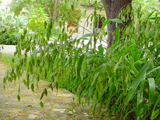Native Plants

Q. Who is Mr. Smarty Plants?
A: There are those who suspect Wildflower Center volunteers are the culpable and capable culprits. Yet, others think staff members play some, albeit small, role. You can torture us with your plant questions, but we will never reveal the Green Guru's secret identity.
Did you know you can access the Native Plant Information Network with your web-enabled smartphone?
Ask Mr. Smarty Plants is a free service provided by the staff and volunteers at the Lady Bird Johnson Wildflower Center.

rate this answer
Thursday - April 02, 2009
From: Low Moor, VA
Region: Mid-Atlantic
Topic: Erosion Control
Title: Plants to prevent bank erosion in Virginia
Answered by: Nan Hampton
QUESTION:
I am looking for good native plant choices for a steep river bank. My driveway is at the top of this slope, so I will need to avoid any plants that would cause erosion. I would prefer low shrubs.ANSWER:
Plants are the ideal solution to stop erosion, not to cause it, and Mr. Smarty Plants has some suggestions. First of all, if your slope is really steep, you might want to consider using erosion-control blankets. The erosion-control fabric works by slowing the runoff water and allowing sediment to fall out rather than be washed away. Seeds are sown under the erosion-control material and grow up through the matting when they germinate. Underneath the matting the roots of the plants growing through the erosion-control material anchor the soil to stop the erosion. If you use erosion-control blankets made of biodegrable material, they will eventually disappear leaving the plants to control the problem.Grasses are excellent plants to use on a slope to stop the erosion because of their extensive fibrous root systems which hold the soil in place. The challenge is to find grasses and other plants that will grow well in your space. You can intersperse shrubs with the grass to make an attractive ground cover. Unfortunately, I don't know what the sunlight and moisture conditions of your slope are. I will, therefore, offer some plants that have very broad light and moisture requirements. If some special conditions exist, you can search for your own plants by going to our Native Plant Database and doing a COMBINATION SEARCH choosing 'Virginia' and the appropriate selections from the other categories.
Grasses and sedges:
Andropogon virginicus (broomsedge bluestem)
Carex blanda (eastern woodland sedge)
Carex pensylvanica (Pennsylvania sedge)
Chasmanthium latifolium (Inland sea oats)
Schizachyrium scoparium (little bluestem)
Low-growing shrubs:
Comptonia peregrina (sweet fern)
Ceanothus americanus (New Jersey tea)
Hypericum prolificum (shrubby St. Johnswort)
Artemisia ludoviciana (white sagebrush)
More Erosion Control Questions
Retention ponds for states in southeast, from Greenville SC
July 14, 2012 - We provide maintenance for Stormwater detention ponds and are looking for native grasses to plant in the bottom and sides of typically dry detention basins. Prefer low growing grasses that spread to...
view the full question and answer
Environmentally friendly native erosion control plants for arid hillside in Austin
July 15, 2006 - Hi,
I'm moving into Agave, the new east side development in Austin. It's currently an arid hill with almost no trees and a steep (by gardening standards) hill.
As a community, we'd love to...
view the full question and answer
Erosion blanket question from Antimony UT
August 03, 2011 - I want to use an erosion control blanket for a hill and want to know what type I should purchase that would allow planting seeds and them growing up through the blanket
view the full question and answer
Plants for a bank too steep to mow
June 24, 2009 - Like the inquiry made in late June of 2008, mine involves a bank that is too steep to mow. However, ours is facing south. I am looking for a native grass, plant or groundcover. Any suggestions?
...
view the full question and answer
Stream Bank Erosion Control for Bryan/College Station
August 16, 2012 - I live in the Bryan/College Station area and need a ground cover to abate erosion on the bank of an intermittent stream. The bank is shaded. Do you have any suggestions?
view the full question and answer
| Support the Wildflower Center by Donating Online or Becoming a Member today. |

